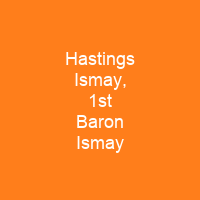General Hastings Lionel Ismay: The Man Behind the Scenes
Who was General Hastings Lionel Ismay, and why should we care about him? Well, if you’re a fan of history or military strategy, you might already know that he played an instrumental role in shaping post-war Europe. But who exactly is this man behind the scenes? Born on 21 June 1887 in Nainital, India, Ismay’s journey from a cavalry soldier to one of the most influential figures in NATO’s early years is nothing short of fascinating.
Early Life and Education
Ismay was born into a family with military roots. His father was a Viceroy’s Legislative Council member, and his mother was an Army colonel. This background certainly influenced his path to becoming a soldier. After attending Charterhouse School and the Royal Military College, Sandhurst, Ismay joined the Indian Army as an officer of the 21st Prince Albert Victor’s Own Cavalry.
Indian Army Service
Imagine being a cavalry soldier in India during the early 20th century. That was Hastings Ismay’s reality.
Ismay served with various British and Indian units before joining the Camel Corps in Somaliland, where he fought against the ‘Mad Mullah.’ Despite his desire to serve on the European front, he remained in Somaliland due to his importance in the operation. His bravery was evident when he fought alongside Adrian Carton de Wiart during an attack on Mohammed Abdullah Hassan’s fortress.
Transition to Civilian Life
After World War I, Ismay transitioned from soldiering to serving in Whitehall as Assistant Secretary of the Committee of Imperial Defence (CID).
In 1925, he became an Assistant Secretary at CID. After being promoted to colonel, he served as military secretary for Lord Willingdon and then returned to CID as Deputy Secretary. In 1938, Ismay became the committee’s secretary and began planning for WWII.
World War II and Beyond
During World War II, Ismay was Winston Churchill’s chief military assistant and staff officer. His role was crucial in running the war effort and effectively linking military and civilian leadership.
Ismay played a key role in planning Operation Overlord and coordinating plans for Operation Bodyguard and Fortitude to deceive Germans about Normandy landings. He attended numerous conferences, including Moscow and Casablanca, where he helped work towards consensus between the Americans and British. His promotion to lieutenant-general in August 1942 was a testament to his importance.
NATO and Post-War Career
After World War II, Ismay’s role shifted from military strategist to diplomat and statesman as he became the first Secretary General of NATO in 1952.
Ismay was instrumental in establishing and defining NATO’s purpose during his tenure. He worked to empower permanent representatives and expand NATO while opposing Soviet membership. His retirement in 1957 marked a new chapter, but not before receiving numerous honors for his service.
Legacy
Ismay’s legacy is one of strategic foresight and unwavering dedication to peace through military alliances.
He served as chairman of the Festival of Britain Council, helping ensure it was national in character. In 1951, he became Secretary of State for Commonwealth Relations under Churchill. His memoirs provide a detailed account of his experiences during and after World War II. Ismay’s contributions to NATO and his role in shaping post-war Europe cannot be overstated.
So, the next time you hear about NATO or the Festival of Britain, remember General Hastings Lionel Ismay, 1st Baron Ismay, who played a pivotal role in these events.

General Hastings Lionel Ismay’s journey from a cavalry soldier in India to one of the most influential figures in NATO’s early years is a testament to his strategic foresight and unwavering dedication. His legacy continues to shape our understanding of military strategy, diplomacy, and peace through alliances.
You want to know more about Hastings Ismay, 1st Baron Ismay?
This page is based on the article Hastings Ismay, 1st Baron Ismay published in Wikipedia (retrieved on December 12, 2024) and was automatically summarized using artificial intelligence.







